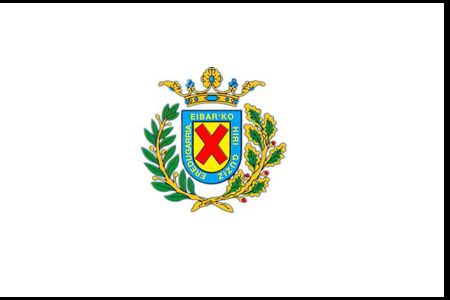Ikurriña Flag

Spanning the French and Spanish border, the Basque Country is home to about three million people, most of whom live on the Spanish side.
Historically, since the ousting of Islamic rule in the 15th century, the area has been strongly Latin-rite Catholic, peppered with a few Occitan pilgrim settlers on their way to and from Santiago de Compostela. The area was relatively autonomous until the realignment of power following the French Revolution (1789–1799) and the Carlist Wars (1833-1876). The struggle has continued since then to regain independence.
Ikurriña just means 'flag' in the Basque language - people there tend to use the Spanish bandera when talking about flags of other nations.

Éibar Flag
Another flag in the region bearing a cross is that of Éibar, a municipality within the province of Gipuzkoa. This industrial city was chartered by Alfonso XI of Castile in 1346. Its chief industry since the 16th century has been the manufacture of armaments, particularly finely engraved small arms. The city's coat of arms bears the same red, green and white colours of the Basque flag.
In the late 19th century, Basque Nationalist brothers Sabino and Luis Arana Goiri designed a flag with a red ground to symbolize the lifeblood of the Biscay people, superimposed by a green saltire to symbolize the Gernika oak tree (itself a symbol of Basque freedom), and both red and green superimposed by the pure white cross symbolizing God. Originally the flag was created for the Biscay region but in 1936 it was adopted as the Basque Flag.

Saint Pierre
and Miquelon
The Basque flag's cross also appears as a canton in the flag of Saint Pierre and Miquelon; a group of small French islands a few miles south of Newfoundland, Canada.
The Flag's Design
During General Franco's rule the Basque Nationalist Party (PNV) were driven into exile, Basque autonomy was dissolved, the flag was declared illegal, and the name Ikurriña and the rest of the Basque language was suppressed in favour of Castillian Spanish. After Franco's death in 1975, all these were restored and the Ikurriña flew again as the official Basque flag.
Like the pagan origin of Christmas colours, red and green are complementary colours (on opposite sides of a colour wheel). The two colours oppose each other and struggle to come together. However, the flag does not so much symbolize the struggle of the people (red) coming to terms with the land (green); rather it shows the approval of God (white) over their nation.
See also Basque Cross (Lauburu)
One of the most popular stories of the French Revolution; Les Misérables